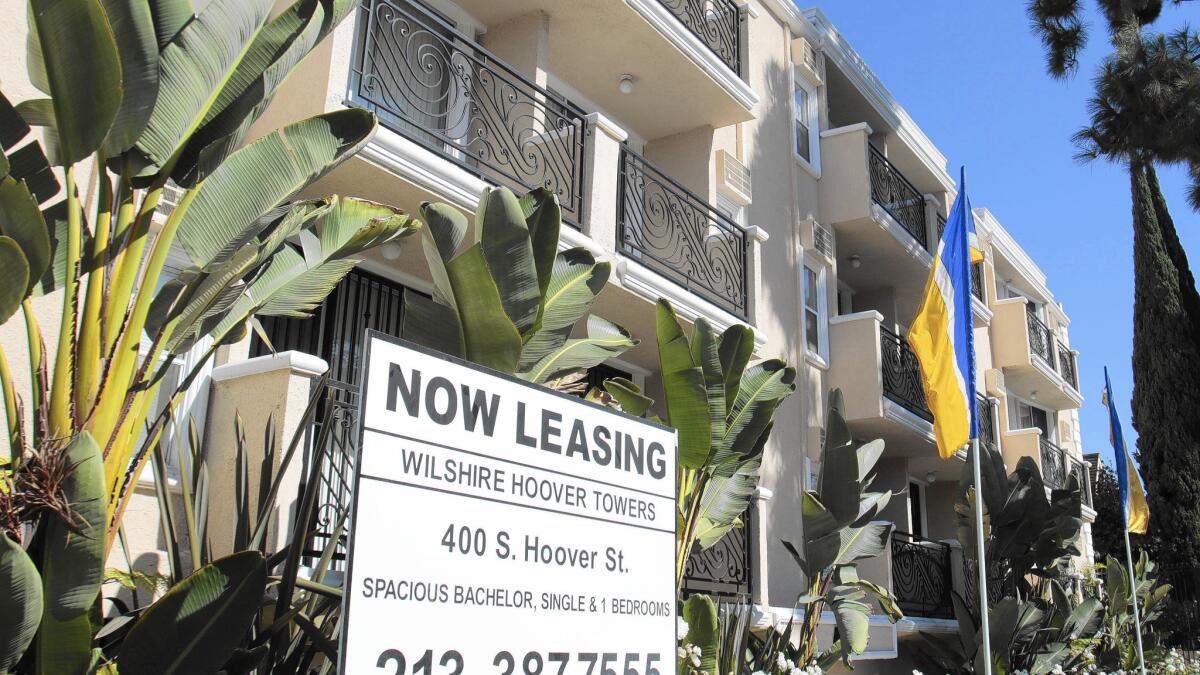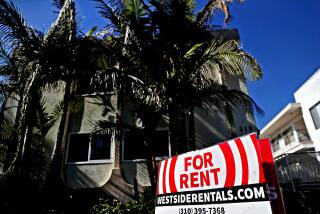Southern California rents to keep climbing over the next two years

Renters, get ready to pay more to live in the Southland.
The average cost of an apartment in the region is projected to grow more than 8% over the next two years, according to a new report out Tuesday, making one of the nation’s least affordable rental markets even less so.
The figures come from a USC study that projects average rents by mid-2016 in Los Angeles County will have climbed 8.2% to $1,857, 8.6% to $1,807 in Orange County and 9.9% to $1,189 in the Inland Empire.
Those growth rates — each of which on an annual basis is faster than was recorded over the last 12 months — reflect surging demand for apartments, a trend that shows no signs of slowing.
“We think rents are going to go up everywhere. There isn’t remotely enough supply,” said Richard Green, director of USC’s Lusk Center for Real Estate. “We’ve never had a situation like this before in Southern California.”
The region has long had a shortage of rental housing. A study earlier this year estimated Los Angeles County needs an additional 500,000 apartments to meet demand, which is surging as job growth picks up and a wave of twentysomethings move out on their own.
Meanwhile, income, especially for working-class households and other likely renters, is flat at best. And apartment construction, although increasing, is nowhere close to keeping up with demand.
“Vacancy rates are not going anywhere,” said Green, who projected the rate in Los Angeles County would actually fall from 3.3% today to 2.9% in mid-2016.
The cost of housing is becoming a long-term economic problem for Southern California, said Daryl Carter, chief executive of Avanath Capital Management, an Irvine-based investment firm that owns $300 million worth of apartment buildings nationwide. And it’s a problem that could feed on itself by pushing good jobs elsewhere.
He pointed to corporate decisions like Tesla Motors’ move last month to open a $5-billion battery factory in Nevada instead of California, and noted that they’re not just driven by incentives and cheap industrial land, but also by housing costs.
The Southland is prosperous now, he said, but if it’s not careful, Carter warned, the region could drift down the path of his hometown, Detroit. The city had one of the nation’s strongest housing markets when he was growing up in the 1960s before countless auto industry jobs, and hundreds of thousands of residents, left.
“California today feels a lot like my childhood in Detroit,” said Carter, speaking on a panel Tuesday about the USC study. “And if we don’t make the right policy decisions, that’s what we could be.”
Another panelist, Bill Witte, chief executive of one of the state’s biggest apartment and condo developers, Related California, said fixing the region’s rent crunch is going to require many small solutions, including easing minimum parking requirements — which can drive up the cost of new construction — and reforming environmental laws that make it easy for opponents to sue and block development.
But perhaps the biggest step local officials can take, he said, is to speed the timeline by which developments win approval.
California has “by far the lengthiest process in the country,” Witte said. “If you really want to do something about costs, address the time it takes to develop.”
Then there are issues that aren’t really about housing but add to the housing affordability crunch — sagging wages for many working-class families.
Raphael Bostic, a former housing official in the Obama administration who now teaches public policy at USC, noted that there are 8.5 million households that receive no housing subsidies and spend at least half their income on rent, a figure that has more than doubled since 2006.
“It’s not just homeless people who are struggling with housing. It’s not just the unemployed. It’s everybody,” he said. “And it’s all over the country.”
Indeed, Green said affordability worries might be the one factor that keeps a lid on rents in the region over the next few years. There’s only so much rents can climb before renters refuse to pay more and decide to double-up with roommates, driving vacancy rates up, and — eventually — rents down.
“That’s the wild card,” Green said. “Can people afford it?”
Twitter: @bytimlogan
More to Read
Inside the business of entertainment
The Wide Shot brings you news, analysis and insights on everything from streaming wars to production — and what it all means for the future.
You may occasionally receive promotional content from the Los Angeles Times.











